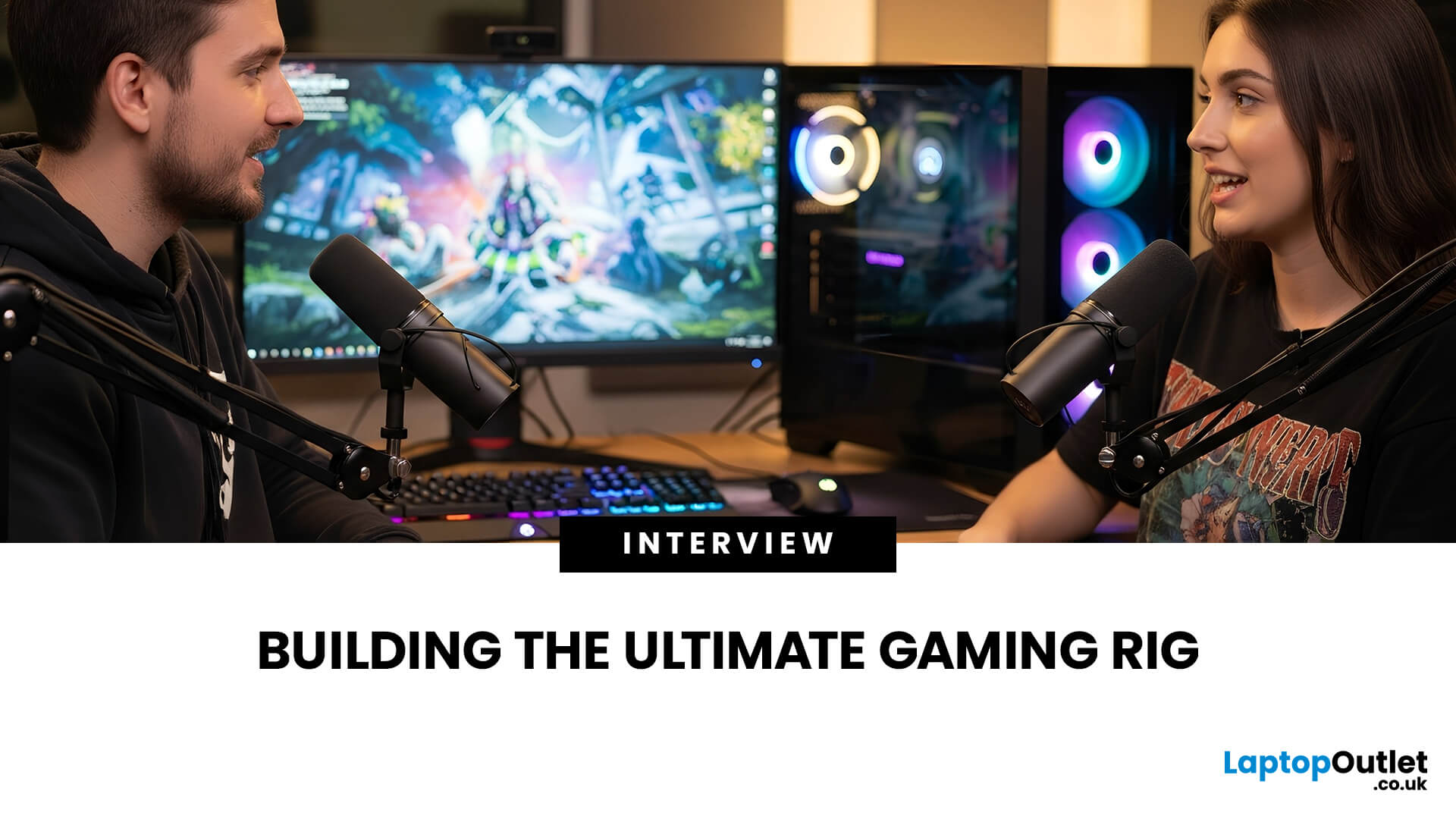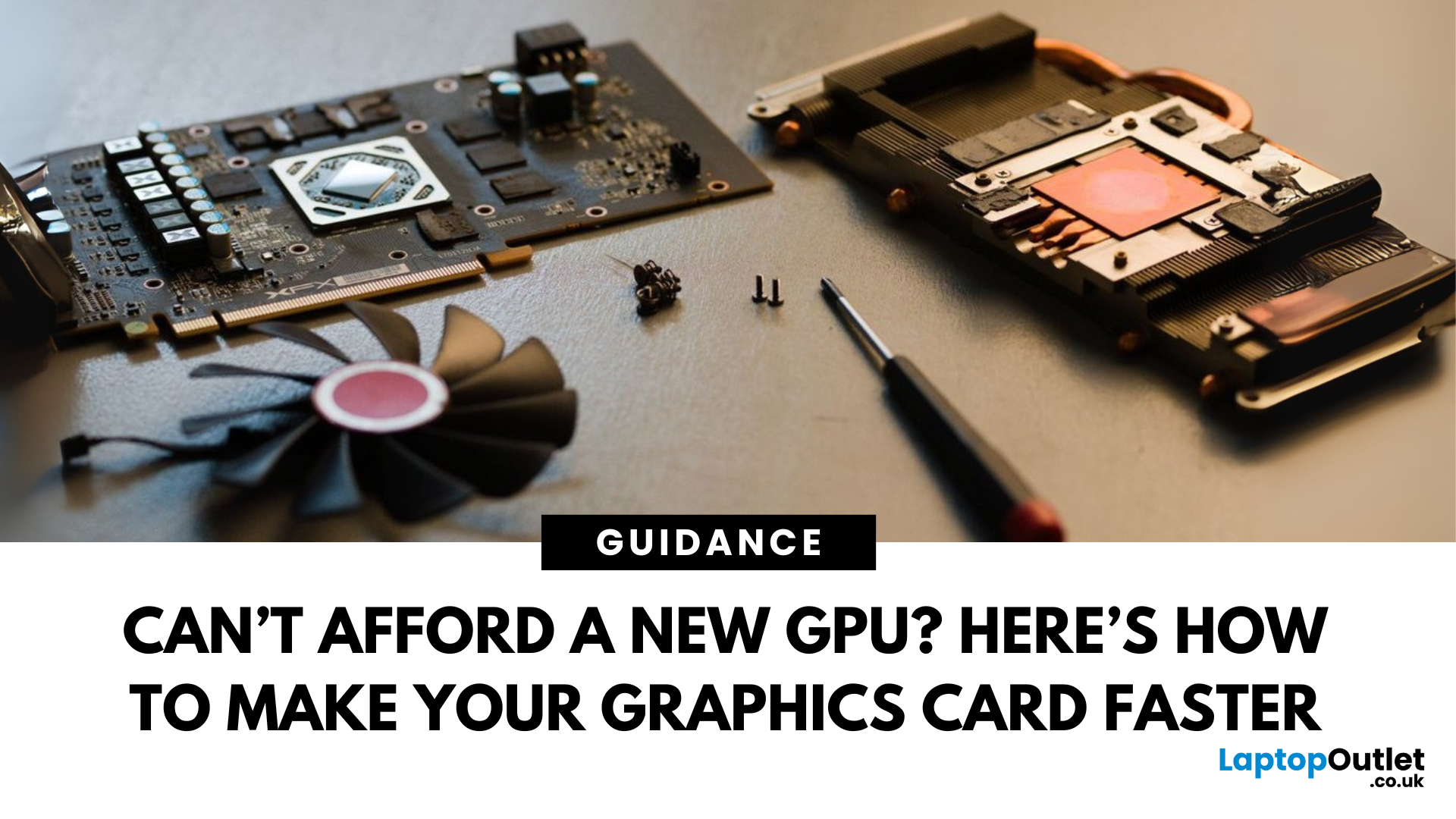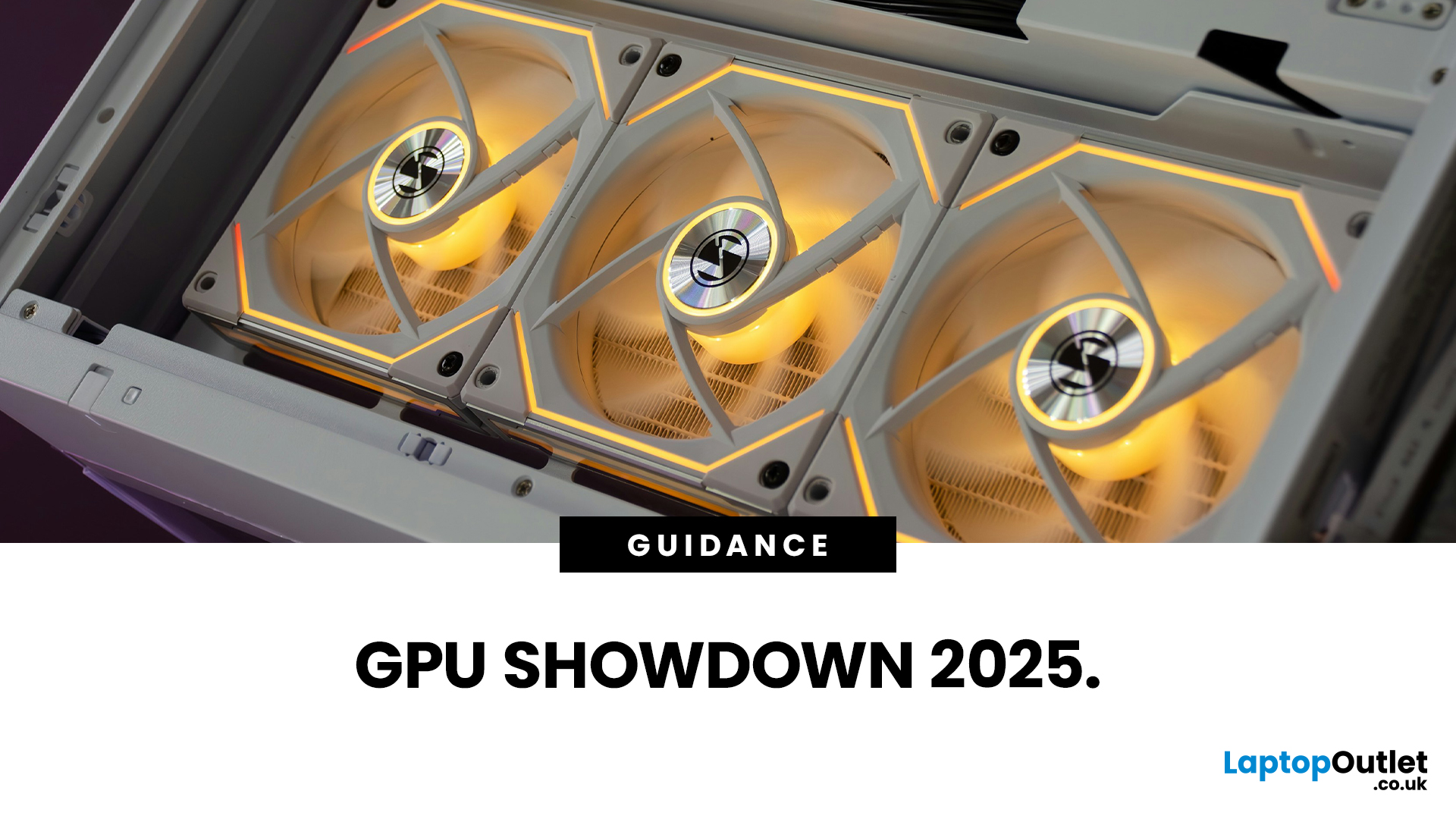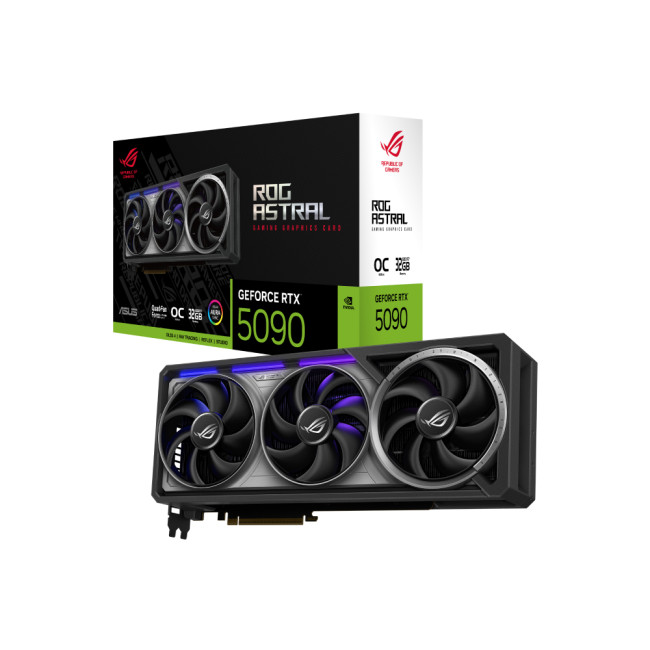Building the Ultimate Gaming Rig: Expert Tips on Choosing the Right Graphics Card

Setting the Scene
Alex: First of all, thanks for having this discussion, Jamie. I’m in the process of upgrading my rig, and I want to get the best GPU for gaming I can afford. But there are so many options out there, and I’m a bit lost, especially with the new 50-series from NVIDIA, and the still-very-solid 40-series.
Jamie: No problem, Alex, happy to help. Upgrading the graphics card is probably the biggest single component decision in a gaming rig (other than maybe the monitor or CPU). So, it’s good that we step through it together.
Why is the Graphics Card Matters
Alex: So, to start with: why is the graphics card so important for a gaming rig?
Jamie: In short, the GPU is what actually renders your game frames, handles complex calculations for lighting, shadows, textures, and especially if you’re gaming at higher resolutions (1440p, 4K) or using high refresh rates. If you pair everything else well (CPU, RAM, storage, PSU, cooling), the graphics card becomes a bottleneck if it’s too weak.

Alex: That’s interesting. So, if I invest in a top-tier card, it might pay off beyond just gaming.
Jamie: Exactly. That’s why this conversation is really a graphics card buying guide. We’ll walk through how you choose one, what features matter, what to look out for.
Understanding the New NVIDIA 50-Series (And Why it Matters)
Jamie: Now, I’ll enlighten you on the latest-gen GPUs. The new NVIDIA GeForce RTX 50 Series is based on the Blackwell architecture and is being marketed as a major leap forward. It uses GDDR7 memory, improved ray-tracing cores and tensor cores for AI workloads, and features like DLSS 4 and Reflex 2.
Alex: What kind of performance boost are we talking about compared to the 40-series?
Jamie: According to specs, substantial. From the digital trends breakdown: the 50-series cards show large memory bandwidth increases, faster clocks, and massive AI/graphics uplift. If you’re gaming at 4K with ray-tracing enabled, the 50-series is very much designed to push you into next-level territory: high framerates, ultra-settings, high refresh rates.
Revisiting the 40-series GPUs
Jamie: The 40-series GPUs (e.g., the RTX 4090, RTX 4080, and others) were based on the Ada Lovelace architecture. For many gamers, they still deliver fantastic performance at 1440p and 4K, often at a lower price now. You can see solid deals dropping on 40-series cards in UK. For creative workloads, you might consider RTX 4080 vs RTX 4090 at a discount compared to launch.
Alex: So, if I’m building a rig now and budget is limited, a 40-series might give me close to ‘best’ performance for less.
Jamie: Correct. But be aware: as new games demand more, and as you push to ultra-settings at 4K or high refresh 1440p, the extra headroom of the 50-series might help.
Key Questions in the Graphics Card Buying Guide
Jamie: Let’s dive into the actual questions you should ask during yourself before buying graphics card.
Question 1: What resolution and refresh rate will you game at?
Alex: I’m gaming on a 1440p 165Hz monitor now, but I’m thinking about upgrading to a 4K 144Hz display within 12-18 months.
Jamie: Good. For 1440p you don’t always need the top-top card. But if you’re planning 4K in future, that means you’ll want a card that can handle 4K at high framerates. So, in terms of best high-end GPUs for 4K gaming, you’re looking at the 50-series or top of the 40-series.
Question 2: What’s your budget and power/cooling budget?
Alex: My budget for GPU is approximately £700-£1000 (GBP), and I have a PSU rated at 850W, with good airflow in the case.
Jamie: With this budget, you can choose RTX 5070 Ti or 5070 of 50-series cards. The 5090/5080 will be higher cost. And your PSU is decent; check the thermal and power draw of the card.
Question 3: What creative/other workloads do you run?

Alex: Occasionally I stream and record gameplay, but I don’t render large 3D scenes yet. But I’d like to do more content creation in future.
Jamie: Then you’ll benefit from a card that’s strong in both gaming and rendering. If you plan 3D work, look at the CUDA core count, VRAM size (12-16GB or more is good), and check benchmarks for 3D. The best GPUs for 3D rendering often overlap with gaming cards, especially in the high end.
Question 4: What features matter (ray tracing, DLSS/FSR, upscaling, VR)?
Jamie: In gaming PC builds, these features allow you to future-proof somewhat. If a card supports upscaling/AI generation of frames, etc., it means your GPU may last longer before becoming outdated.
Which Card Segments to Pick – Suggestions

Alex: So, given all that, what are the recommended tiers I should look at?
Jamie: Here’s one way to breakdown:
- Entry to Mid-High Gaming: If your budget is modest or you game at 1440p only, consider something like the lower end of the 50-series (e.g., RTX 5060/5050) or a strong 40-series like RTX 4070.
- High-End Gaming & Futureproofing for 4K: The upper-mid in the 50-series (e.g., RTX 5070 Ti/5080) or a top 40-series card (RTX 4090 or 4080 depending on price) if found at good value.
- Ultimate Performance/Creative Workloads: The very top 50-series (RTX 5090) is aimed at that segment. If you really want the best GPU for gaming (and do 3D work) you might go there but expect a significant cost.
Practical Checklist Before You Buy
Jamie: Let’s draw up a quick checklist you should run through before purchasing:
- Case compatibility: Check card length, width (some have triple-slot coolers).
- PSU Requirement: Ensure your power supply meets the manufacturer recommendation (including rail capacity). For example, some 50-series cards may require 1000 W or more depending on configuration.
- Monitor Resolution/Refresh: Make sure GPU matches what you actually plan; if you never go beyond 1440p 60Hz then ultimate 4K gear may be overkill.
- Cooling and Airflow: Ensure your case has good airflow and consider whether you’ll go air vs liquid.
- VRAM and Memory Bandwidth: Higher resolutions and asset-rich games demand more VRAM, especially if you also do render.
- Support for Features: Ray tracing, DLSS/FSR, etc. The newer the generation, the better support for next-gen games.
- Budget vs Value: Consider current UK pricing, deals. Sometimes previous gen (40 series) may represent better value.
- Future-Proofing: If you intend to keep the card for 4-5 years, stepping up to a 50-series makes sense; if you’ll upgrade sooner, a slightly lower tier may suffice.
Alex: That’s a lot to think about, but it’s good to have a framework.
Specific Card Examples
Jamie: Let’s talk specific examples relevant to UK buyers now.
- The 50-series examples include the RTX 5090, RTX 5080, RTX 5070 Ti, RTX 5070, RTX 5060. Retailers in the UK already stock 50-series models.
- For the 40-series, you have the well-known RTX 4090, RTX 4080, etc. These are still very capable.
Alex: I like the idea of “best high-end GPUs for 4K gaming”. Which of these hit that mark?
Jamie: You’ll find that the 50-series is more expensive at launch, so you might find better value with a 40-series card that is discounted.
Gaming vs Creative Workload Balance
Alex: Jamie, you do 3D work, right? So, how different are the requirements compared to pure gaming?
Jamie: Well, thank you for asking such an important question. The difference lies mostly in VRAM, driver optimisation, thermal headroom, and long-duration workloads. In gaming you might run a game for an hour or two; in rendering you could have 3-4 hours of continuous GPU usage. If you look at 3D rendering GPUs, the emphasis is not just framerate but sustained throughput, memory size, and driver stability.
So, if you’re building a rig that does both, game now and maybe edit/render later, you might choose a slightly higher tier than if you were gaming only.

Final Advice & Decision Time

Jamie: To wrap up: for someone wanting the best GPU for gaming, here’s how I would advise:
- If budget is ample and you want futureproofing (especially 4K, ray tracing, creative use) → go for a 50-series high-end card (e.g., RTX 5080/5090) if your PSU, cooling and case allow.
- If budget is tighter, or you’re primarily gaming at 1440p or 4K but don’t need ultra-high refresh yet → consider a high-end 40-series card (e.g., RTX 4090 or 4080) which may offer excellent value.
- For creative workloads beyond gaming (streaming, 3D, rendering) consider stepping up in VRAM and cooling.
- Watch UK pricing: inflation, deals, availability matter a lot. Even best high-end graphics cards can vary significantly in price week to week.
Alex: That’s really helpful. I’m leaning toward a high-mid 50-series (maybe RTX 5070 Ti) now, given my budget and future plan to go 4K. But I’ll keep an eye on discounts for a 40-series just in case.
Jamie: Any time. Happy to answer follow-up questions when you pick models.
Related Articles

January 28, 2025
The laptop market in 2025 has been completely transformed by NVIDIA GeForce RTX GPUs, offering unparalleled power, visuals, and versatility. With over 80% of high-performance laptops now featuring RTX GPUs, they’ve become the go-to choice for gamers, creators, and professionals alike. Whether you're chasing the cutting-edge performance of the latest RTX 50 series laptops or the proven reliability of RTX 40 series models, there’s an option for every need and budget.
NVIDIA's advancements in ray tracing, DLSS 3.5, and AI-powered acceleration make these laptops 50% faster than their predecessors, delivering lifelike graphics and exceptional efficiency. The gaming industry alone has seen a 35% rise in demand for RTX-powered laptops in 2025.
Ready to dive in and find the perfect RTX laptop? Read on as we explore the top models, including their specs, pricing, and unique features, so you can make an informed choice. Don’t miss the ultimate guide ahead!
What Makes NVIDIA GeForce RTX Laptops Stand

February 20, 2025
Looking for portable graphics cards? Graphics cards are an essential component for gamers, creative professionals, and tech enthusiasts. As the market evolves, new models are released with cutting-edge technology, while older ones become more affordable. Whether you are looking for the latest high-performance GPUs or seeking budget-friendly options, 2025 presents some fantastic deals on graphics cards.
In this blog, we will explore the best deals on gaming graphics cards, including RTX and AMD GPUs, and help you find the most value-packed choices from top brands. Whether you are searching for discounts on AMD graphics cards or affordable Nvidia graphics cards, we have you covered.
Why 2025 Is a Great Year for Buying a Graphics Card
The GPU market in 2025 has stabilised significantly compared to previous years, making it an ideal time to grab some of the best deals. Key factors influencing the affordability of graphics cards this year include:
- Increased Supply: Manufacturers have ramped

February 25, 2025
In 2025, gaming and content creation are more accessible than ever, thanks to Nvidia’s lineup of budget-friendly graphics cards. Whether you're a casual gamer, a competitive esports player, or a creative professional, finding the right GPU doesn’t have to drain your wallet. The market is filled with options that deliver exceptional performance without the premium price tag, ensuring you get the best value for your investment.
From the power-efficient GTX 1650 to the feature-rich RTX 3060, Nvidia continues to redefine budget gaming. These GPUs offer remarkable frame rates, smooth gameplay, and cutting-edge features like DLSS and ray tracing—bringing next-gen technology within reach for everyone. With the right choice, you can enjoy immersive visuals, faster rendering, and seamless multitasking without compromise.
With so many options available, it can be challenging to determine which budget Nvidia GPU is the best fit for your needs. Whether you’re looking for smooth 1080p gaming, entry-level

May 29, 2025
Virtual reality is the way forward when looking for total immersion and enjoying entertainment in another dimension. Whether you're stepping into alien landscapes, racing through hyper-realistic circuits, or exploring entire worlds from your living room, VR takes everything you love about gaming and cranks it up to another level. But to truly make the most of it, your PC needs to be more than just average; it needs serious graphical muscle.
If you plan to upgrade your system for a smoother, sharper, and more responsive VR experience, choosing the best graphics card for virtual reality experiences is key. And with so many options now on the market, narrowing it down can be daunting. That's why we've done the legwork for you.
Unlike standard gaming, virtual reality demands more from your hardware. Take it as running dual high-resolution displays - except one is strapped to your face, and every frame counts. Frame rates need to stay consistently high, latency needs to be minimal, and

July 02, 2025
The RTX 5050 arrives as a timely and much-needed addition to NVIDIA’s mid-range line-up. With GPU prices escalating and older models ageing out of relevance, this card positions itself as a smart compromise between performance, features, and affordability. Targeted at gamers, upgraders, and budget-conscious users alike, it strikes an appealing balance that’s increasingly rare in the entry-level space. If you're considering an RTX 5050 upgrade, this RTX 5060 graphics cards review has something for you.
Architecture & Specifications: A Capable Foundation
Under the hood, the RTX 5050 is built on NVIDIA’s Blackwell architecture, the same foundation used in high-end models like the RTX 5090 graphics card. This gives it access to 5th-gen Tensor cores and 4th-gen RT cores, cutting-edge tech for a budget-friendly GPU. The card features 2,560 CUDA cores, a boost clock of up to 2,570 MHz, and 8GB of GDDR6 memory with 320 GB/s bandwidth. Despite its modest memory interface, performance stays sharp

July 02, 2025
Let’s face it. Graphics cards are expensive. And while everyone wants that shiny new GPU to max out game settings or improve their creative workloads, it’s not always realistic. Between supply issues, steep prices and rapid technology cycles, buying a new graphics card can often feel like a luxury rather than a necessity.
The good news is that you don’t need to replace your GPU to breathe new life into your gaming rig or workstation. With a little time, care, and smart system tweaks, you can get more performance out of your current card and make it run quieter, cooler and faster.
In this guide, we’ll walk you through practical ways to improve your GPU’s performance, longevity, and efficiency without splashing out on brand-new hardware. If you’re looking to upgrade graphics card performance without replacing it entirely, you’re in the right place.
Tips to Make your Graphics Card Faster Without Upgrading It
-
Clean and Maintain Your GPU for a Performance Boost
Before we even touch the software

October 22, 2025
We’ve been deep in the trenches with today’s top-tier GPUs, testing them across real-world gaming sessions, editing timelines, and production rigs. This isn’t just another spec dump. It’s a curated breakdown of what actually matters when you're pushing pixels or chasing frames. Whether you're building for buttery 4K gameplay or need something that won’t choke on a multi-cam 8K edit, we’ve cut through the marketing noise to highlight what each card nails (and where it stumbles). No filler, no fluff, just the kind of insight we’d want before dropping serious cash on a new GPU.
ASUS GeForce RTX 5090 ROG Astral 32GB OC
Also Known As:
- ROG STRIX RTX 5090
- NVIDIA GeForce RTX 5090 ROG Astral OC
- The Beast from the Future
Overview & Standout Features
The ASUS RTX 5090 ROG Astral isn’t just a GPU; it’s a flex. This monster packs 32GB of next-gen GDDR7 VRAM, triple axial-tech fans, and more RGB than your setup probably needs (but still wants). ASUS has taken NVIDIA’s flagship and strapped

October 23, 2025
If you’ve ever felt overwhelmed stepping into the world of GPUs, you’re not alone. Choosing the right graphics card is one of the trickiest parts of building or upgrading a PC. In this guide, I’ll walk you through how to choose a graphics card, explain critical specs, compare AMD vs NVIDIA, help you pick thebest GPU for gaming, and highlight what to consider ifyou’re going for4K gaming.
This graphics card buying guideis your ultimate companion to navigate through the maze of options. We'll break down key specs, performance insights, comparisons, and practical tips to help you make an informed purchase, especially ifyou'reshopping at Laptop Outlet, one of the UK’s trusted tech retailers.
Understanding What a Graphics Card Does
A graphics card, or GPU (Graphics Processing Unit), is the powerhouse responsible for rendering images, videos, and animations on your screen. Think of it as the heart of your visual experience. It determine show smoothly your games run, how sharp your 4K videos
